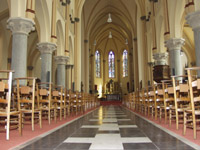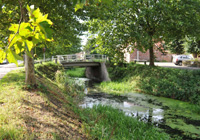The Meetjesland in the north of East-Flanders, Belgium

Zelzate
Zelzate is mentioned for the first time in a deed of Saint-Genois of 1236 as a district of Assenede. A 1242 document carrying the seal of Johanna of Constantinopel charges the Assenede Corporation with the administration of Assenede and Zelzate. In 1288 the Gravejansdijk (Duke John's Dike) is completed.
 The year 1377 was long remembered for a terrible flood which destroyed so much
of the northern part of Flanders and Zealand. In this same year the polder
farmers and people working in the peat industry built a small chapel dedicated to
Saint Laurentius at the "Endeken".
The year 1377 was long remembered for a terrible flood which destroyed so much
of the northern part of Flanders and Zealand. In this same year the polder
farmers and people working in the peat industry built a small chapel dedicated to
Saint Laurentius at the "Endeken".
There exists a patent letter of 13/6/1526 by Emperor Charles V addressed to the St. Sebastian's Guild of Zelzate. In 1531 His Holiness Pope Clemens VII orders religious services to be celebrated in the St. Laurentius Chapel at Zelzate.
In 1547 Emperor Charles V grants permission for the construction of the "Sassevaart" (Sasse Canal) between Roodenhuize (Red House) and the sea dike of the Braeckman, then still an inland sea.
 On 10/1/1554 a bull by His Holiness Pope Clemens VIII creates the parish of Zelzate.
On 10/1/1554 a bull by His Holiness Pope Clemens VIII creates the parish of Zelzate.
In 1559 Philip II, king of Spain and Portugal and champion of the Roman Catholic Counter-Reformation creates new dioceses (bishoprics). Assenede and Zelzate are now part of the new diocese of Ghent.
In 1568 the "Geuzen" (Beggars), a derogatory name for the Protestants, sacked the new part of Assenede and burned its church to the ground.
The year 1570 sees the separation of the parishes of "Selsaete" and Assenede by order of the famous bishop Cornelius Jansenius. Zelzate's new parish priest is the Reverend Jacobus Bertram. The chapel at the Endeken is rebuilt. There is a terrible storm in the night of 31 October and 1 November and on All Saints Day much of the country is under several feet of (sea)water.
In 1579 Zelzate is part of the Northern Provinces and France begins her attempts to recover the Southern Netherlands.
In 1585 Zelzate belongs once again to Spain still ruled by King Philip II. The next year the Spanish build the St-Anthonis Fortress on the east side of the Ghent Canal. This same year Zelzate lives through another inundation.
 Spain was at the height of her power during the reign of Philip II but he
couldn't suppress the revolt of the Netherlands and in 1588 he lost much of
his Invincible Armada with which he had hoped to invade England to overthrow
Queen Elisabeth I, the champion of Protestantism.
Spain was at the height of her power during the reign of Philip II but he
couldn't suppress the revolt of the Netherlands and in 1588 he lost much of
his Invincible Armada with which he had hoped to invade England to overthrow
Queen Elisabeth I, the champion of Protestantism.
In 1598 Philip II donates the Southern Netherlands (corresponding more or less with what is now Belgium) to his daughter Isabella who was betrothed to Albert, the Archduke of Austria. Our people hoped with the reign of Albert and Isabella there would be no more wars. When the couple came to their new possessions they were received with great enthusiasm.
1611 is a great year for future genealogists: the first register of births is opened in Zelzate's Saint-Laurentius parish. In 1613 the Franciscus Polder is dammed in. Also in 1613 the renovated and enlarged church at the Endeken is reconsecrated. It has three brand new altars.
In 1621 our country is once again ruled by Spain. And in 1625 there is once again a fearsome storm with the inevitable consequences i.a. inundation. But there is also the construction of new dikes. And in this same year the Four Corporations are separated during the Eighty Years' War: two fortresses were built with a chapel in between.
On 15/10/1629 Jaecques De Voghelaere, born at Zelzate, an "unfree" boatman in the service of the King is hanged at Ghent on the "Coornaert", the "Korenmark" (Wheat Market). He was condemned to death for spying for the Dutch.
In 1634 a dike is built from Hulst to the St. Anthonis fortress at Sas van Ghent (a "sas" is a lock, a sluice). In the next year there was a furious battle between the fortresses of Raepenburch and Zelzate. In 1635 Zelzate has a new parish priest Lambert Van Roye. Mass is celebrated not in the church but in the fortresses. Was the church damaged ? Or occupied by soldiers ?
 In 1645 Willem of Orange takes the fortresses from the marques Fonderatie.
In 1645 Willem of Orange takes the fortresses from the marques Fonderatie.
Europe's Thirty Years' War ends in 1648 with the Peace of Westphalia and the Treaty of Münster recognizes the independence of the "Dutch Republic of the United Provinces". Sas of Ghent is part of this Dutch Republic. That same Treaty of Münster also closes the Scheldt River to navigation and little by little Amsterdam takes over from Antwerp as Europe's major commercial city.
In 1672 a French army of 100.000 men crosses the Rhine and invades the Dutch Republic of William III. Louis XIV wants to punish the Dutch who gave shelter and help to his enemies. The Chateau Ter Loveren serves as a prison. Once again Zelzate's church is not used for religious services. In 1673 the Dutch save Amsterdam and the Holland province by opening the locks and piercing dikes thus flooding Zelzate. This conflict ends in 1678. But the peace is short-lived because in 1691 we hear of a French army commanded by the Marquis De Boufflers who uses Zelzate as a base for sorties against the Dutch.
The Treaty of Utrecht (1713) ends the War of the Spanish Succession. The Southern part of the Netherlands goes to Austria.
On 11/5/1777 the renovated and enlarged church at the Endeken is solemnly consecrated by Monseigneur Van Eersel.
In 1779 the first bridge across the Sasse Canal in Zelzate was inaugurated. It was a swivel bridge in the "Groenstraat", (Green Road) near an inn called "De Roos" (the Rose).
In 1794 France defeats the Austrians at Fleurus near Charleroi and now our country becomes French territory.
On 15/11/1797 Joannes A. Hazaert became the parish priest of Zelzate because he had sworn allegiance to the godless French state. This meant his church staid open.
1798: the "Boerenkrijg" (Farmers' Revolt). It wasn't just some farmers who revolted against the French.
14/01/1808: spring-tide from the Wester-Scheldt: 20 dead and 30,000 acres inundated.
1815: with the defeat of Napoleon at Waterloo our country is now part of the Kingdom of the Netherlands.
 In 1816 there is far too much rainfall and this causes inundations, sickness,
the plague, famine and profiteering.
In 1816 there is far too much rainfall and this causes inundations, sickness,
the plague, famine and profiteering.
1817 King Willem I founds the State University of Ghent.
On 18/11/1827 the new Canal Ghent-Terneuzen is inaugurated by King Willem I.
In 1830 Belgium becomes an independent state. The next year Leopold of Saxe Coburg Gotha is crowned its first King (Leopold I).
In 1843 Father Petrus De Sutter expands the church at the Endeken: he adds a porch and installs a new organ.
31/01/1853: four Sisters from Wachtebeke found a school for lace making at Oosttragel.
1856: the crowning of King Leopold II, the second king of Belgium.
 On 27/10/1864 the Sisters buy land and the chateau of Henri van den Watteyne.
The next year they moved into the chateau with their kindergarten and primary
school.
On 27/10/1864 the Sisters buy land and the chateau of Henri van den Watteyne.
The next year they moved into the chateau with their kindergarten and primary
school.
A railway is built from Ghent to Terneuzen and in 1865 the section from Wondelgem to Zelzate is put into use.
1870 a new town hall is built in the "Groenstraat" (Green Street) (now the Franz Wittouck Lane)
1870 the Ghent-Terneuzen Canal is widened in Belgium to 56.3 meters.
1873 the Sisters open an old peoples' home in Church Street and their primary school is classified as an officially recognized school.
1875: the plague strikes and in three months 29 adults and 27 children die.
In 1876 at the Oosttragel they lay the first stone of the new church which will be consecrated on 07/08/1879. But before the end of the year the burgomaster J. Honoré Willems has already confiscated the old church and the cemetery.
In 1889 the Brothers of Charity start a boarding school, the St John Berchmans School. It caters for boys from 12 to 18 years old. On 18/03/1892 it is completely destroyed by fire.
In 1903 they widen and deepen the Canal Ghent-Terneuzen: it is now 97 meters wide and 8,75 meters deep. From Zelzate to Terneuzen the canal has a new bed and at Terneuzen the West Lock is built.
In 1914 King Albert who was crowned in 1909 spends the night in the house of burgomaster Cesar De Clercq.
In 1918 the St.-Laurentius Church is bombarded.
1924 sees the end of the orphanage which the Sisters had opened in their convent in 1885.
For Belgium the year 1940 means the start of WW II. On 20 May 1940, less than 20 years after the repair of the damage of WW I, they dynamite Zelzate's church tower. It crashes through the vaults of the main nave. The invaluable organ and so much more is lost. The reconstruction will last from 1950 to 1952: the neogothic interior is rebuilt the way it was before the war.
In 1960 the canal is again deepened and widened. In 1962 a steelworks is opened in Zelzate which by now has been transformed from an agricultural into an industrial town.
Until 1776 Zelzate was administratively an integral part of Assenede. That is good enough a reason, as far as we are concerned, for considering it forever an inalienable part of our Meetjesland.
Our source for most of the above is a great and well informed website on Zelzate and its history: we are most grateful to Mr. Martin Acke for allowing us to translate and bring here to you so much of his information. Those who speak Dutch and want more details may click here for a very rewarding visit of his website.

More pictures
Our Meetjesland
— Table of Contents
— Find something in this Meetjesland website

MijnPlatteLand.com
Most recent update : 22-04-2021
Copyright Notice (c) 2025